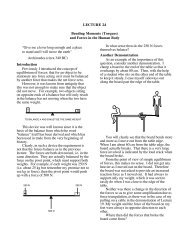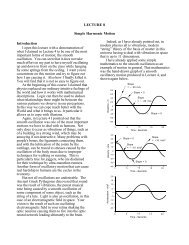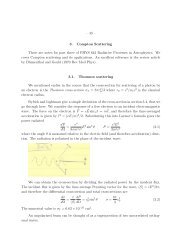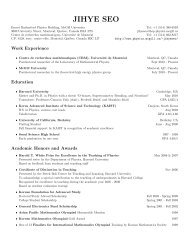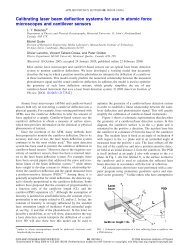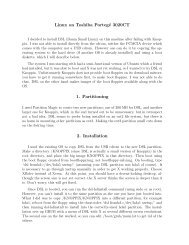Atomically defined tips in scanning probe microscopy - McGill Physics
Atomically defined tips in scanning probe microscopy - McGill Physics
Atomically defined tips in scanning probe microscopy - McGill Physics
You also want an ePaper? Increase the reach of your titles
YUMPU automatically turns print PDFs into web optimized ePapers that Google loves.
3.1 ATOMIC FORCE MICROSCOPY IN ULTRA-HIGH VACUUM 27monic with amplitude A and us<strong>in</strong>g canonical perturbation theory, the spr<strong>in</strong>g constantof the tip-sample <strong>in</strong>teraction can be averaged over the oscillation cycle <strong>in</strong> thefollow<strong>in</strong>g way [65]:〈k ts (z)〉 = 1 ∫ Aπk ts (z − q) √ A 2 − q 2 dq, (3.3)2 A2 −A〈kand the <strong>in</strong>duced frequency shift can be calculated from ∆f = f ts(z)〉0 2k N. The follow<strong>in</strong>gsubsection discusses different force-distant relations, which can be directlyused to calculate ∆f. In general, for small oscillation amplitudes, the frequencyshift is <strong>in</strong>dependent of the amplitude and proportional to the tip-sample forcegradient k ts , as shown above. However, for amplitudes that are large comparedto the range of the tip-sample <strong>in</strong>teraction, the frequency shift is a power functionof the amplitude, ∆f ∝ A − 3 2[66]. This relationship is later used for experimentalcalibration of the oscillation amplitude (see Section 4.2).Conservative forcesForces between the tip and the sample can be divided <strong>in</strong>to various classes.The primary dist<strong>in</strong>ction made here is based on energy conservation dur<strong>in</strong>g theoscillation cycle. Forces that are not delayed <strong>in</strong> time, i.e. have only an <strong>in</strong>-phasecomponent and do not depend on the velocity of the cantilever, are conservative.This is <strong>in</strong> contrast to the e-EFM method (see Section 3.1.3 and Chapter 8), where theelectrostatic force is delayed with respect to the tip oscillation and leads to energydissipation.Van der Waals forces (vdW) arise from the <strong>in</strong>teraction between fluctuat<strong>in</strong>gdipoles <strong>in</strong> the atoms <strong>in</strong> the tip and the sample. Consider<strong>in</strong>g just two atomicdipoles, the vdW <strong>in</strong>teraction leads to a very weak and usually attractive force.However, if the contributions from all tip and sample atoms are summed up, itcan result <strong>in</strong> forces of several nN, which under certa<strong>in</strong> experimental conditionscan dom<strong>in</strong>ate the total tip-sample <strong>in</strong>teraction. Tak<strong>in</strong>g a sphere placed close to aflat surface as an approximation of the tip-sample geometry, the vdW force is describedby:F vdW = − HR6z 2 , (3.4)



